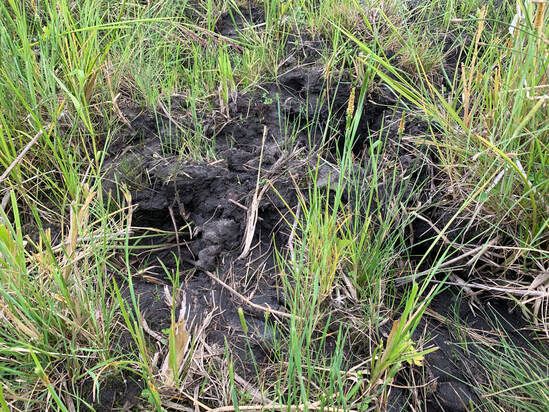
Pugging is a common issue associated with livestock on wet ground. It’s a term used to describe the deep holes and mounds left behind when large herbivores like horses or cattle graze or walk on soft ground. Soft ground can be in a riparian area, a pasture after a heavy rain, or an ephemeral wetland.
Large herbivores are most likely to cause pugging because of how heavy they are. Cattle, bison, and horses aren’t light animals, weighing from 800 to well over 2500 pounds, and their weight is focused on four hooves instead of soft feet like ours. Those hooves cut sharply into the soil, where they can damage plants and the soil surface.
Small ruminants like sheep and goats are as likely to cause pugging, but not to the extent of large herbivores.
Pugging is often considered challenging to repair in conventional grazing systems because it is seen as a near-permanent issue that will take years to rejuvenate.
However, there is some hope. It just takes looking at them differently than what the continuous-grazing proponents often tell us.
Why & How It Happens
Mismanagement, usually.
Let me expand on that. Pugging occurs when animals are allowed to remain in a sensitive area for longer than they should.
This could be accidental, which is most often the case. Very, very rarely is it purposeful.
Some grazers have said they made the mistake of having animals that were too heavy on the pasture, causing pugging even on high ground. Greg Judy has attested to this, making this one of the many reasons he switched to smaller-sized cattle. It was within his context because, in Missouri, he gets a lot of moisture that makes pastures softer. Therefore, using his smaller South Devon cattle instead of the conventional beef cows he used to custom graze years ago makes sense.
Indeed, a 1000-lb cow is usually easier on pastures than a 1600-pound cow.
However, timing is also a significant factor. Animals that stay in one place for too long, regardless of their size, are more likely to cause damage than animals that are quickly moved.
Also, it’s a factor of time if animals are moved through or permitted to graze in riparian areas that should have otherwise been protected from those animals. Wetlands and riparian zones that are wet from significant rainfall or spring runoff are more sensitive to damage by grazing herbivores. However, one or two isn’t nearly as much of a worry compared with several more and repeatedly.
For example, some moose tracks in a riparian zone aren’t going to amount to much compared with 50 cows visiting that same spot repeatedly because that’s their primary water source. It’s the same if a couple of your cows got out and did a little trampling near a pond. That’s no biggie compared with 50 or 100 head causing worrying (though not irreversible) impact.
How to Prevent or Reduce It?
The best prevention is sheer avoidance. Keep the animals off the pasture, riparian zone, or wetland area for as long as necessary. Only put them back on when the ground has dried enough that their hooves won’t cause significant damage.
Sacrifice paddocks are considered to be the more traditional means of doing this. It’s an area designated to help save your pastures. It likely won’t remain in grass, but that is not an issue. It should be on high ground with good drainage, allowing it to dry quickly after a significant rain event. It also should be an area where your animals will not stand in a temporary lake. Animals standing in water will likely have foot issues like footrot or founder. It may also be where you may have to provide feed; thus, having dry, high ground for them to eat is ideal. Animals should also have access to some form of natural or man-made windbreak.
It doesn’t have to be fancy or require a lot of investment. However, this article suggests putting in a cement or limestone feed pad (or similar) for them to stand on, along with a loafing shed with a surface or sub-surface drainage system.
An alternative solution is frequent pasture moves. This reduces hoof impact by preventing them from revisiting that sensitive area. Temporary electric fencing adds flexibility, with different paddock sizes and shapes according to the landscape.
A more permanent riparian zone or wetland will require more permanent fencing solutions. Semi-permanent or permanent fencing will discourage animals more readily than temporary electric fencing. Building an off-site water source is highly recommended if a water source needs to come from that area. The wetland and riparian zone will receive less damage, and cleaner water will also be accessible to your animals.